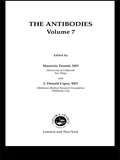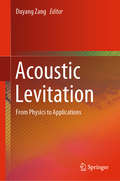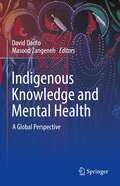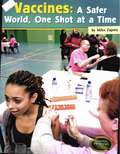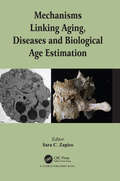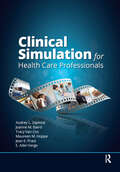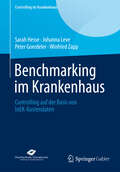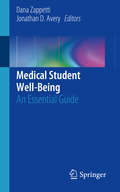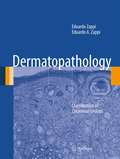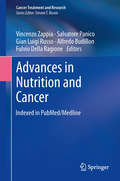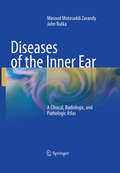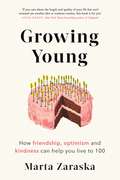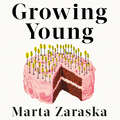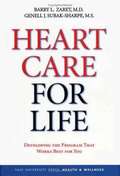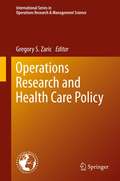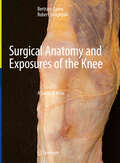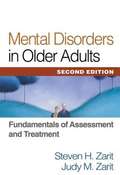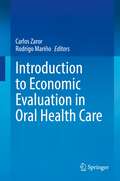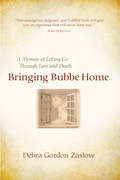- Table View
- List View
The Antibodies (The\antibodies Ser.)
by Maurizio Zanetti J. Donald CapraFrom diagnostic tools to therapy against cancer, infections and autoimmune diseases, antibodies serve many purposes, yet our knowledge of them is still incomplete. The Antibodies: Volume 7 continues with a comprehensive review of topics of contemporary interest including major breakthroughs such as the advent of monoclonal antibodies and the develo
Acoustic Levitation: From Physics to Applications
by Duyang ZangThis book systematically introduces readers to the fundamental physics and a broad range of applications of acoustic levitation, one of the most promising techniques for the container-free handling of small solid particles and liquid droplets. As it does away with the need for solid walls and can easily be incorporated into analysis instruments, acoustic levitation has attracted considerable research interest in many fields, from fluid physics to material science. The book offers a comprehensive overview of acoustic levitation, including the history of acoustic radiation force; the design and development of acoustic levitators; the technology’s applications, ranging from drop dynamics studies to bio/chemical analysis; and the insightful perspectives that the technique provides. It also discusses the latest advances in the field, from experiments to numerical simulations. As such, the book provides readers with a clearer understanding of acoustic levitation, while also stimulating new research areas for scientists and engineers in physics, chemistry, biology, medicine and other related fields.
Indigenous Knowledge and Mental Health: A Global Perspective
by Masood Zangeneh David DantoThis book brings together Indigenous and allied experts addressing mental health among Indigenous peoples across the traditional territories commonly known as the Americas (e.g. Canada, US, Caribbean Islands, Mexico, Bolivia, Venezuela, Ecuador and Brazil), Asia (e.g. China, Korea, Japan, Taiwan and Indonesia), Africa (e.g. South Africa, Central and West Africa) and Oceania (New Guinea and Australia) to exchange knowledge, perspectives and methods for mental health research and service delivery. Around the world, Indigenous peoples have experienced marginalization, rapid culture change and absorption into a global economy with little regard for their needs or autonomy. This cultural discontinuity has been linked to high rates of depression, substance abuse, suicide, and violence in many communities, with the most dramatic impact on youth. Nevertheless, Indigenous knowledge, tradition and practice have remained central to wellbeing, resilience and mental health in these populations. Such is the focus of this book.
Vaccines: A Safer World, One Shot at a Time (Fountas & Pinnell LLI Purple #Level W)
by Miles ZapataVaccines: A Safer World, One Shot at a Time by Miles Zapata *** SOLVING PROBLEMS SERIES
Mechanisms Linking Aging, Diseases and Biological Age Estimation
by Sara C. ZapicoThis book focuses on four of the hallmarks of aging: aspartic acid racemization, advanced glycation end products, telomere shortening and mitochondrial mutations; describing their role in aging and diseases; and their application to age-at-death estimation in forensic sciences in greater depth, displaying the interconnecting pathways among these processes. An additional chapter related to Epigenetics and its role in aging, diseases, and forensic age estimation is also included. This book is aimed at a broad audience: from students being introduced to aging, diseases, and forensic science research to scientists in biomedicine and forensics complementing their knowledge in their respective fields while also increasing their knowledge in other disciplines.
Clinical Simulation for Healthcare Professionals
by Audrey L. Zapletal Joanne M. Baird Tracy Van Oss Maureen M. Hoppe Jean E. Prast E. Adel HergeAs simulated learning experiences are increasingly used in healthcare education to enhance student engagement and experience, Clinical Simulation for Healthcare Professionals serves as a resource for the utility, design, and implementation of simulation-based education in occupational therapy, physical therapy, speech-language pathology, and nursing.Using best practice methods, academic and clinical rehabilitation professionals of all levels will learn how to design and implement clinical simulations. These can be used as a tool for education, assessment, research, and skills integration.Written by Drs. Audrey Zapletal, Joanne Baird, Jean Prast, Maureen Hoppe, Tracy Van Oss, and Adel Herge, Clinical Simulation for Healthcare Professionals provides comprehensive information about commonly used simulation methods including high and low technology simulations, simulated patients, task trainers, and role play. Also included are step-by-step instructions for how to build simulation experiences in a variety of settings and for various learning and teaching needs. How-to information assists instructors who want to develop and integrate simulation-based education into a new or existing curriculum.The example simulations inside represent an array of different practice and focus uses. Each stage of the simulation is addressed from creation to learning assessment to debriefing.Simulation integrates the worlds of education, health professions, and the performing arts within a singular enriching experience. Clinical Simulation for Healthcare Professionals fulfills a need for educators looking to develop the skills needed to create complex and dynamic learning environments.
Controlling im Krankenhaus: Das Zusammenspiel von Werten, Prozessen und Innovationen (Controlling im Krankenhaus #6)
by Winfried ZappDieses Buch fromuliert und beleuchtet Werte aus der Sicht der Ökonomie und Anforderungen aus der Ethik als Ausgangsbasis für eine differenzierte Betrachtung von Controlling. Als ein wesentlicher Ansatz der letzten Jahre wird die Corporate Social Responsibility (CSR) konstruktiv-kritisch analysiert. Neben der Wertediskussion ist die Bedeutung der Prozesse für das Gesundheitswesen immer wieder hervorgehoben worden. In zwei Beiträgen wird dabei die Ergänzung um das Blueprinting und die Möglichkeiten des Lean Management herausgearbeitet. Soll eine Ausrichtung an Werten und eine verbesserte Struktierung von Prozessen gelingen, dann sind unabdingbar Innovationen zu gestalten und voranzutreiben. Dabei wird in diesem Buch ein Innovationscontrolling entwickelt, um diese Entwicklung zu begleiten und die Bedeutung von Verzerrungen hervorgehoben. Ausführungen zu einer Optimierung des Controlling unter Beachtung der Konzeption um ein Behavioral Accounting und zu einer fallmixorientierten Vorgehensweise schließen das Buch ab. Nur wenn Klarheit und Konsensus über die angestrebten Werte besteht, können Prozesse eingeleitet werden, um das Arbeitsziel otpimaler zu erreichen. Dazu bedarf nicht nur eingefahrener Wege und Überlegungen, sondern innovativer Gestaltungskraft. Das Buch möchte hierzu Wege aufzeigen.
Deckungsbeitragsrechnung für Krankenhäuser: Analyse – Verfahren – Praxisbeispiele (Controlling im Krankenhaus)
by Winfried ZappDie Deckungsbeitragsrechnung ist eine Teilkostenrechnung und kann unterschiedlich gestaltet und ausgerichtet sein, wobei sich unter anderem kostenträger- und kostenstellenorientierte Verfahren unterscheiden lassen. In diesem Buch werden beide Verfahren exemplarisch entwickelt und mit Zahlen und Daten jeweils eines ausgewählten Beispiel-Krankenhauses anwendungsorientiert dargestellt. Die kostenträgerorientierte Variante wird aus den Vorgaben des Kalkulationshandbuches konzipiert, so dass eine schnelle Herleitung mit den Kalkulationsdaten möglich ist. Die kostenstellenorientierte Deckungsbeitragsrechnung wird ebenfalls in einem Modellhaus anwendungsorientiert hergeleitet und mit den verschiedenen Analysemöglichkeiten dargestellt. In einem dritten Beispiel wird herausgearbeitet, wie ein Controlling aus einer reinen Vollkostenrechnung Analysedaten bereitstellen kann. Somit werden unterschiedliche Verfahren differenziert vorgestellt, sodass deutlich wird, welche Arbeitsschritte notwendig sind, welche Analyse-Möglichkeiten sich daraus ergeben, um darauf aufbauend ein anwendungsorientiertes Controlling voranzutreiben und zu gestalten. Dieses Buch richtet sich an Führungskräfte in Krankenhäusern und Gesundheitseinrichtungen sowie an Studierende aus dem Bereich Gesundheitsmanagement, Controlling und Rechnungswesen.
Qualitäts- und Risikomanagement im Krankenhaus: Analyse – Verfahren – Anwendungsbeispiele (Controlling im Krankenhaus)
by Winfried ZappDas Qualitäts- und Risikomanagement im Gesundheitswesen hat in den vergangenen Jahren zunehmend an strategischer Bedeutung gewonnen: Durch jüngere Gesetzesänderungen können Verfehlungen im Bereich der Qualität und der Fehleinschätzung des Risikos direkten negativen Einfluss auf das Leistungsgeschehen des Krankenhauses nehmen. Dieses Fachbuch führt in das Thema Qualitäts- und Risikomanagement und deren Ausgestaltung im Krankenhaus ein. Es zeigt die Rahmenbedingungen im Gesundheitswesen auf und stellt zunächst die Analyse und Optimierung klinischer Behandlungspfade als grundlegendes Instrument vor, um erfolgreiches Qualitäts- und Risikomanagement miteinander zu verbinden. Ergänzende Transparenz schaffen klinisches Prozessmanagement, Casemanagement und unterstützende Kennzahlensysteme. Der zweite Teil des Buches fokussiert vor allem auf zwei konkrete Instrumente des Risikomanagements und stellt diese ausführlich vor: Das Critical Incident Reporting System (CIRS) und das Global Trigger Tool (GTT) werden analysiert und verglichen und so die Methoden, Unterschiede sowie Stärken und Schwächen abgeleitet. Die Ausführungen sind dabei anwendungsorientiert dargestellt und mit Praxisbeispielen hinterlegt. Das Buch möchte so eine praxisnahe Entscheidungshilfe für Führungskräfte sein, um für das individuelle Krankenhaus das jeweils passende Verfahren finden zu können.
Benchmarking im Krankenhaus: Controlling auf der Basis von InEK-Kostendaten (Controlling im Krankenhaus)
by Winfried Zapp Sarah Hesse Johanna Leve Peter GoerdelerDas Benchmarking stellt ein wichtiges Controlling-Instrument von Planungs- und Kontrollprozessen in Unternehmungen dar. Es ermöglicht einen systematischen quantitativen und qualitativen Vergleich gleichartiger Unternehmungen. Mithilfe des Einsatzes dieses Instrumentes können Unternehmungen ihre Marktposition im Wettbewerbsumfeld einschätzen sowie Verbesserungspotenziale identifizieren und ausschöpfen. Im Krankenhausbereich ist es sinnvoll, im Rahmen einer Benchmarking-Analyse die InEK-Kostendaten als Vergleichsgröße zu verwenden. Sie haben eine hohe Aussagekraft, da sie die Erlöse eines Krankenhauses darstellen. Die Autoren führen daher ein Benchmarking auf Basis der InEK-Kostendaten auf DRG-Ebene am Beispiel eines Modellkrankenhauses durch und leiten daraus Implementationsmöglichkeiten für die Praxis ab. Grundlage bildet eine zuvor entwickelte anwendungsorientierte Vorgehensweise.
Cashflow-orientiertes Liquiditätsmanagement im Krankenhaus: Analyse – Verfahren – Praxisbeispiele (Controlling im Krankenhaus)
by Winfried Zapp Aline Wurm Julia OswaldDieses Fachbuch befasst sich mit der Frage, inwiefern durch das cashflow-orientierte Liquiditätsmanagement die aktuelle und zukünftige Zahlungsfähigkeit von Krankenhäusern sichergestellt werden kann. Dazu wird zunächst dargestellt, welche Informationen die Instrumente Cashflow-Statement und cashflow-basierte Liquiditätsplanung beinhalten müssen, damit das Management durch zielgerichtete finanzwirtschaftliche Entscheidungen das finanzielle Gleichgewicht einer Unternehmung damit auch die Liquidität sicherstellen kann. Anschließend werden das Cashflow-Statement und die Liquiditätsplanung in einer Modelleinrichtung beschrieben, analysiert und bestehende Defizite sowie mögliche Ergänzungen und Weiterentwicklungen aufgezeigt. Damit verdeutlicht die praktische Untersuchung Optimierungsmaßnahmen für die festgestellten Schwachstellen. Ergänzend werden weitere Vorschläge zur Verbesserung der bisherigen cashflow-orientierten Instrumente vorgestellt. Die cashflow-orientierte Liquiditätsplanung wird mit ihrer lang-, mittel- und kurzfristigen Perspektive wird in Berichtsform entwickelt und erläutert.
Medical Student Well-Being: An Essential Guide
by Dana Zappetti Jonathan D. AveryThis book tackles the most common challenges that medical students experience that lead to burnout in medical school by carefully presenting guidelines for assessment, management, clinical pearls, and resources for further references. Written by national leaders in medical student wellness from around the country, this book presents the first model of care for combating one of the most serious problems in medicine. Each chapter is concise and follows a consistent format for readability. This book addresses many topics, including general mental health challenges, addiction, mindfulness, exercise, relationships and many more of the important components that go into the making of a doctor.Medical Student Well-being is a vital resource for all professionals seeking to address physician wellness within medical schools, including medical students, medical education professionals, psychiatrists, addiction medicine specialists, hospitalists, residents, and psychologists.
Dermatopathology
by Eduardo ZappiThis book shall assist the microscopist in a practical way, with the help of three mainstays, a. clinical information, b. the resources a standard histopathology laboratory may offer and c. the light microscope, to approach and solve the diagnostic problems he/she may face in the field of dermatopa¬thology. In fact, this is the way in which the senior author of this book has been successfully working over thirty years in his capacity as director of a private dermatopathology laboratory.
Advances in Nutrition and Cancer (Cancer Treatment and Research #159)
by Vincenzo Zappia Salvatore Panico Gian Luigi Russo Alfredo Budillon Fulvio Della RagioneThis book comprises proceedings from the Third International Conference on Advances in Nutrition and Cancer, held in Naples in May 2012. This highly multidisciplinary meeting analyzed "nutrition and cancer" from different perspectives and on the basis of distinct and up-to-date experimental approaches. Knowledge on the relation between lifestyle, diet, and cancer is explored in a number of contributions, and the role of dietary intervention in cancer patients is discussed. Issues of vital interest to the research community, such as epidemiological and experimental oncology (genetics, epigenetics, and the mechanisms of action of natural compounds in the diet), receive detailed consideration. A further key topic is the emerging molecular technologies (the "omics") that can cast light on the interplay between nutrition and human malignancies. Chapters take the form of reviews that include sections presenting expert opinions.
Diseases of the Inner Ear
by Masoud Motasaddi Zarandy John RutkaThis book is a comprehensive atlas of the clinical conditions that commonly involve the inner ear and lateral skull base. Each disorder or disease is meticulously and beautifully illustrated, with accompanying informative text. An important feature of the book is that no disorder is described from a single point of view. Instead, the clinical features are linked with both radiologic and pathologic findings to provide an all-encompassing picture of the condition in question. This is feasible because the book is the result of years of intense collaborative teamwork between departments at the University of Toronto and the Tehran University of Medical Sciences, and includes many clinical and pathologic images that could only be acquired in major referral units. It is anticipated that this atlas will assist greatly in improving collaboration between clinicians and surgeons in the diagnostic, therapeutic, and surgical management of disorders in this challenging area.
Growing Young: How Friendship, Optimism and Kindness Can Help You Live to 100
by Marta Zaraska'If you care about the length and quality of your life but can't stomach yet another diet or workout routine, this book is for you' - Adam Grant, New York Times bestselling author 'Finally, a lifestyle book that transcends diet and exercise for solutions for living longer' - Dan Buettner, National Geographic Fellow and New York Times bestselling author A smart, research-driven case for why optimism, kindness and strong social networks will help us live to 100.What to do to live long? From fountain-searching Ponce de Leon to pill-popping Silicon Valley techies humanity has been trying to pinpoint the answer for centuries, often fixating on all the wrong things: miracle diets, miracle foods, miracle supplements. We skip gluten and invest in exercise gadgets. We swallow vitamins. We obsess about BMI. While healthy nutrition and physical activity are indeed important for health, there are things we all too often sacrifice in favour of fad diets that have an outsize impact on our centenarian potential. Friendships. Purpose in life. Empathy. Kindness. Science shows that these 'soft' health drivers are often more powerful than diet and exercise.Consider the numbers: studies show that building a strong support network of family and friends lowers mortality risk by about 45 per cent. Exercise, on the other hand, can lower that risk by 23 to 33 per cent. Eating six servings of fruit and veg per day can cut the danger of dying early by 26 per cent, while following the Mediterranean diet by 21 per cent. For volunteering, it's 22 to 44 per cent. Many more examples like this led Marta Zaraska to her ultimate conclusion: you should be contemplating your purpose in life, not the best fitness tracker to buy.Humans are social animals. Over the course of our evolution we've developed intertwined systems that regulate our social lives on one hand and our physiology on the other, contributing to our centenarian potential. The amygdala and the insula in the brain, the social hormones oxytocin and serotonin, the vagus nerve, the HPA stress axis - these all link our bodies and our minds, contributing to our centenarian potential. We feel safe when we are surrounded by friendly others. The nervous system, the gastrointestinal system, the immune system all function properly when the tribe is there for us and when we are there for the tribe. We flourish as part of a group.Marta Zaraska based Growing Young on hundreds of research papers and on interviews with dozens of leading scientists from fields as diverse as molecular biochemistry, cyber psychology, marketing and zoology. The book's research took her to rather unexpected places, too: catching wild mice in the woods of England, sipping super-smoothies at a longevity bootcamp in Portugal and arranging flowers with octogenarians in Japan. In the end, all the studies, the interviews and the travels brought her to a simple conclusion: self-improvement, commitment to growing as a person, can also help us grow younger. To Michael Pollan's famous statement on health: 'Eat food, not too much, mostly plants,' she now adds: 'Be social, care for others, enjoy life.'
Growing Young: How Friendship, Optimism and Kindness Can Help You Live to 100
by Marta Zaraska'If you care about the length and quality of your life but can't stomach yet another diet or workout routine, this book is for you' - Adam Grant, New York Times bestselling author 'Finally, a lifestyle book that transcends diet and exercise for solutions for living longer' - Dan Buettner, National Geographic Fellow and New York Times bestselling author A smart, research-driven case for why optimism, kindness and strong social networks will help us live to 100.What to do to live long? From fountain-searching Ponce de Leon to pill-popping Silicon Valley techies humanity has been trying to pinpoint the answer for centuries, often fixating on all the wrong things: miracle diets, miracle foods, miracle supplements. We skip gluten and invest in exercise gadgets. We swallow vitamins. We obsess about BMI. While healthy nutrition and physical activity are indeed important for health, there are things we all too often sacrifice in favour of fad diets that have an outsize impact on our centenarian potential. Friendships. Purpose in life. Empathy. Kindness. Science shows that these 'soft' health drivers are often more powerful than diet and exercise.Consider the numbers: studies show that building a strong support network of family and friends lowers mortality risk by about 45 per cent. Exercise, on the other hand, can lower that risk by 23 to 33 per cent. Eating six servings of fruit and veg per day can cut the danger of dying early by 26 per cent, while following the Mediterranean diet by 21 per cent. For volunteering, it's 22 to 44 per cent. Many more examples like this led Marta Zaraska to her ultimate conclusion: you should be contemplating your purpose in life, not the best fitness tracker to buy.Humans are social animals. Over the course of our evolution we've developed intertwined systems that regulate our social lives on one hand and our physiology on the other, contributing to our centenarian potential. The amygdala and the insula in the brain, the social hormones oxytocin and serotonin, the vagus nerve, the HPA stress axis - these all link our bodies and our minds, contributing to our centenarian potential. We feel safe when we are surrounded by friendly others. The nervous system, the gastrointestinal system, the immune system all function properly when the tribe is there for us and when we are there for the tribe. We flourish as part of a group.Marta Zaraska based Growing Young on hundreds of research papers and on interviews with dozens of leading scientists from fields as diverse as molecular biochemistry, cyber psychology, marketing and zoology. The book's research took her to rather unexpected places, too: catching wild mice in the woods of England, sipping super-smoothies at a longevity bootcamp in Portugal and arranging flowers with octogenarians in Japan. In the end, all the studies, the interviews and the travels brought her to a simple conclusion: self-improvement, commitment to growing as a person, can also help us grow younger. To Michael Pollan's famous statement on health: 'Eat food, not too much, mostly plants,' she now adds: 'Be social, care for others, enjoy life.'
SPIONs as Nano-Theranostics Agents
by Atefeh Zarepour Ali Zarrabi Arezoo KhosraviThis Brief introduces SuperParamagnetic Iron Oxide Nanoparticles (SPIONs), the different synthesis approaches, their applications in the field of diagnostics and treatment and finally as theranostic agents in cancer.
Heart Care for Life: Developing The Program That Works Best for You
by Barry L. Zaret Genell Subak-SharpeMore than 70 million Americans have some form of heart disease. For each of them, obtaining accurate information about the disease and the many options for dealing with it can be both empowering and life saving. In this book, cardiologist Dr. Barry L. Zaret and Genell Subak-Sharpe offer up-to-date facts about the best treatments available and an innovative approach that shows how treatment programs can be tailored to meet the needs of each unique patient. There are no short-term fixes and no one-size-fitsall programs, explain Zaret and Subak-Sharpe. Although certain characteristics are common to each form of heart disease and its treatments,these constants must be tempered against individual variables. The authors outline the constants for the full range of cardiovascular conditions, from angina and heart attacks to high blood pressure and cardiac arrhythmias. They then guide readers through the process of assessing personal variables to develop an individual treatment and life-style program. Written in a warmly reassuring style, this indispensable guide to heart care offers realistic hope and specific directions for designing a lifelong heart care program. Filled with practical advice, instructional case histories, a philosophy for controlling your health, self-tests to assess risk, and questions to ask your doctor, it looks toward an even better future for those with heart disease.
Operations Research and Health Care Policy
by Gregory S. ZaricOperations research tools are ideally suited to providing solutions and insights for the many problems health policy-maker's face. Indeed, a growing body of literature on health policy analysis, based on operations research methods, has emerged to address the problems mentioned above and several others. The research in this field is often multi-disciplinary, being conducted by teams that include not only operations researchers but also clinicians, economists and policy analysts. The research is also often very applied, focusing on a specific question driven by a decision-maker and many times yielding a tool to assist in future decisions. The goal of this volume was to bring together a group of papers by leading experts that could showcase the current state of the field of operations research applied to health-care policy. There are 18 chapters that illustrate the breadth of this field. The chapters use a variety of techniques, including classical operations research tools, such as optimization, queuing theory, and discrete event simulation, as well as statistics, epidemic models and decision-analytic models. The book spans the field and includes work that ranges from highly conceptual to highly applied. An example of the former is the chapter by Kimmel and Schackman on building policy models, and an example of the latter is the chapter by Coyle and colleagues on developing a Markov model for use by an organization in Ontario that makes recommendations about the funding of new drugs. The book also includes a mix of review chapters, such as the chapter by Hutton on public health response to influenza outbreaks, and original research, such as the paper by Blake and colleagues analyzing a decision by Canadian Blood Services to consolidate services. This volume could provide an excellent introduction to the field of operations research applied to health-care policy, and it could also serve as an introduction to new areas for researchers already familiar with the topic. The book is divided into six sections. The first section contains two chapters that describe several different applications of operations research in health policy and provide an excellent overview of the field. Sections 2 to 4 present policy models in three focused areas. Section 5 contains two chapters on conceptualizing and building policy models. The book concludes in Section 6 with two chapters describing work that was done with policy-makers and presenting insights gained from working directly with policy-makers.
Surgical Anatomy and Exposures of the Knee: A Surgical Atlas
by Bertram Zarins Robert ŚmigielskiIn many medical schools, the teaching of anatomy has been reduced. Since most knee operations today are performed with the aid of an arthroscope, an orthopedic resident may infrequently be exposed to open knee surgery. Therefore, today’s orthopaedic surgeon may have inadequate knowledge of knee anatomy and little experience with open knee operations. However, in a typical orthopaedic practice, open knee surgery is still required, especially in trauma. This book is written to fill this knowledge gap.This anatomical and surgical atlas is different from other anatomy books in many respects. It is written for surgeons. Anatomical structures that are surgically important are emphasized, whereas those that have little clinical bearing are not stressed. Structures are shown in the position of the knee that surgery is typically performed, such as 90 degrees flexion for medial and lateral approaches. Plentiful high-resolution photographs and illustrations of meticulous new dissections are presented. New imaging techniques are used to demonstrate structures, such as MRI and high-resolution computed tomography. Structures are demonstrated at varying degrees of knee flexion, such as the patellofemoral articulation. Commonly used surgical exposures are clearly described and illustrated.Written by orthopaedic surgeons who have years of hands-on experience, Surgical Anatomy and Exposures of the Knee will be a tremendous resource to refresh knowledge of pertinent knee anatomy, plan a surgical exposure, and avoid complications of open knee surgery.
Mental Disorders in Older Adults, Second Edition
by Steven Zarit Judy ZaritIllustrated with abundant clinical material, this book provides essential knowledge and skills for effective mental health practice with older adults. It demonstrates how to evaluate and treat frequently encountered clinical problems in this population, including dementias, mood and anxiety disorders, and paranoid symptoms. Strategies are presented for implementing psychosocial interventions and integrating them with medications. The book also describes insightful approaches for supporting family caregivers and addresses the nuts and bolts of consulting in institutional settings. Combining their expertise as a researcher and an experienced clinician, the authors offer a unique perspective on the challenges facing older adults and how to help them lead more fulfilling and independent lives. Three reproducible forms can also be downloaded and printed in a convenient 8 1/2" x 11" size.
Introduction to Economic Evaluation in Oral Health Care
by Carlos Zaror Rodrigo MariñoThis is the first known book on economic evaluations specifically geared to oral health professionals. The book serves as a starting point that explains the concepts and tools required for practitioners with little or no formal training or experience in economic evaluation to conduct such evaluations in oral health(care). It provides the foundation for applying economic evaluation principles to oral health programs as well as more advanced technical information for those interested in acquiring knowledge of health economics within the context of oral health care.In the book, the authors describe the different types of economic evaluation and discuss their role and application in oral health care. Topics explored among the chapters include:Why carry out an economic evaluation in oral health care?Aspects of decision modelling for economic evaluation in oral health careInterpreting economic evaluation in oral healthWorked examples in cost-effectiveness, cost-benefit, and cost-utility analysesAssessing the quality and usefulness of economic evaluation in oral health: a practical approach for cliniciansUsing economic evaluations to inform decision-making in oral health: TransferabilityEconomic evaluation: uses and potential uses in oral health policy developmentIntroduction to Economic Evaluation in Oral Health Care has an applied orientation that emphasizes practical solutions to managing existing problems and situations in oral health care. As such, the book is essential reading for oral health professionals including dentists, oral health therapists, and dental hygienists, as well as students in the oral health professions. The text is also an appropriate and useful resource for other health practitioners and managers who are interested in enhancing their practical understanding of economic evaluation including health economists and other health professionals and decision-makers.
Bringing Bubbe Home
by Debra Gordon ZaslowDebra Zaslow was humming along on baby-boomer autopilot, immersed in her life as a professional storyteller, wife of a Rabbi, and mother of two teenagers when she felt compelled to bring her 103-year-old grandmother, Bubbe, who was dying alone in a nursing facility, home to live and die with her family. Zaslow had no idea if she would have the emotional stamina to midwife Bubbe to the other side. Bringing Bubbe Home is the story of their time together in Bubbe’s last months, mingled with scenes from the past that reveal how her grandmother’s stories of abuse, tenacity, and survival have played out through the generations of women in the family. Debra watches her expectations of a perfect death dissolve in the midst of queen-size diapers, hormonal teenagers and volatile caregivers, while the two women sit soul-to-soul in the place between life and death. As she holds her grandmother’s gnarled hand and traces the lines of her face, Debra sees her own search for mothering reflected in her grandmother’s eyes. When Bubbe finally dies, something in Debra is born: the possibility to move into the future without the chains of the past.
Unternehmen Zahnarztpraxis: Erfolgreich organisieren, delegieren, digitalisieren, skalieren (Erfolgskonzepte Zahnarztpraxis & Management)
by Frank Zastrow Wolfgang SchmittDieses Buch erzählt von einem Zahnarzt, der die moderne Zahnarztpraxis neu gedacht hat. Begleiten Sie ihn auf seinem Weg und erfahren Sie auf unterhaltsame Weise, wie Sie die Faktoren Zeit, Geld und Leben in einen vernünftigen Einklang bringen. Entscheidend sind kluge, unternehmerische Strategien, um Freiräume zu gewinnen für das, was Ihnen wirklich wichtig ist. Wer vom Getriebenen im Hamsterrad zum Gestalter seines eigenen (Arbeits-)Lebens werden will, kommt an diesem Buch nicht vorbei. Und auch, wer nicht sofort alles anders machen möchte, findet viele nützliche Anregungen. Schaffen Sie die Basis für wirtschaftlichen Erfolg und Lebensqualität zugleich und lernen Sie:Ihre Zahnarztpraxis souverän zu führenDie eigene Expertise weiterzuentwickelnFreiraum für Außerberufliches zu schaffenRegenerationsphasen zu nutzenOrganisierenInterne Prozessoptimierung und klare VerantwortungsbereicheQualitätsmanagement als ChanceModerne maßgeschneiderte Inhouse-KommunikationssystemeDelegierenWas gebe ich wie an wen?Das optimale PraxisteamErfolgsfaktor WertschätzungDigitalisierenPatientengewinnung und -bindung online/offlineWas bieten Sie, was andere nicht haben?Empfehlungs-Marketing und Online-BewertungenSkalierenWelche Praxisform passt zu Ihnen?Einzelpraxis, Gemeinschaftspraxis oder MVZ?Rechtliche und wirtschaftliche Unterschiede
